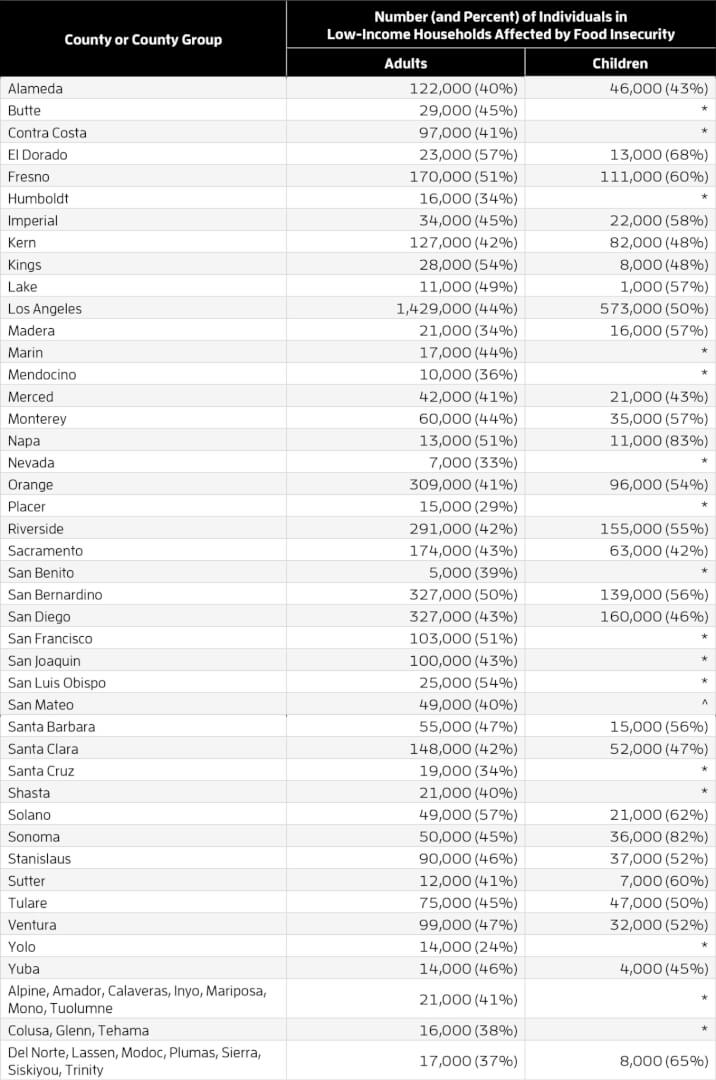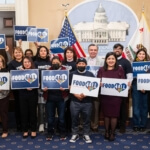Struggling to Make Ends Meet: Food Insecurity in CA
Published on Feb 24, 2020 in Adults, Child Nutrition, School-Aged Children, State Legislation
The Issue
Across California, 4.7 million adults and 2.0 million children live in low-income households affected by food insecurity. Food insecurity means having limited, uncertain, or inconsistent access to the quality and quantity of food that is necessary to live a healthy life. Having sustained access to enough food is tied to positive social, physical, and mental health outcomes.
While the data shared in this factsheet focus on Californians with incomes below 200% of the official federal poverty measure ($50,930 for a family with two adults & two children),1 food insecurity also affects households with higher incomes.2
In many California communities, the official federal poverty measure does not reflect the true level of need – and neither do program eligibility criteria based on that measure.3 Below is a comparison of the maximum allowable income (before deductions) for CalFresh, income limits for school meal programs, and the living wage deemed necessary to meet the basic needs of a family of four in California.4

Though the living wage for basic needs varies by California county, in all cases that wage exceeds the highest allowable income for public nutrition programs such as CalFresh and free or reduced-price school meals.5 Families who fall into the gap between a living wage and program eligibility struggle to meet their most basic needs – and must do so without having access to the very nutrition assistance programs that are intended to prevent hunger and poor nutrition.

County & County Group Data
Data sources and other details for the following tables are included in the Technical Notes. Numbers of individuals are rounded to the nearest thousand. Percentages of individuals are rounded to the nearest whole number. “Low-income” is defined as income below 200% of the official federal poverty measure. “Children” refers to individuals under the age of 18.

*Estimates excluded due to statistical instability ^ Estimate suppressed due to small sample size
Technical Notes
Data for this factsheet was drawn from the California Health Interview Survey (CHIS) 2015-16. Los Angeles, CA: UCLA Center for Health Policy Research. More information about CHIS is available at: http://healthpolicy.ucla.edu/chis/Pages/default.aspx
CHIS measures food insecurity through the Six-Item Short Form of the Food Security Survey Module developed by researchers at the National Center for Health Statistics in collaboration with Abt Associates Inc. The module assesses food insecurity at the household level. This analysis describes the number of people who reside in food-insecure households. More information about the module is available at:
https://www.ers.usda.gov/topics/food-nutrition-assistance/food-security-in-the-us/survey-tools
Acknowledgements
California Food Policy Advocates thanks researchers at the UCLA Center for Health Policy Research for providing food insecurity data from the California Health Interview Survey (CHIS). We gratefully acknowledge their efforts and the valuable data that their work brings to light.
1 The official federal poverty measure is calculated each year by the U.S. Census Bureau. The measure is used to establish nationwide poverty thresholds that vary by household size. For example, the 2018 poverty threshold for a family of four (two adults and two children) is $25,465. In other words, at $25,465 per year, the family has an income that is 100% of the official poverty threshold. The family would be described as living “in poverty” according to the official poverty measure. However, the official poverty measure does not take into account all resources a
family may have (e.g., tax credits, public programs) or all necessary expenses (e.g., medical costs, child care). The official poverty measure also ignores variations in the cost of living across different locations. https://www.census.gov/topics/income-poverty/poverty.html
2 Analyses of food insecurity among higher income households are uncommon. However, an analysis of the Los Angeles County Health Survey found that among households with income below 300% of the federal poverty level, more than 13 percent are food insecure. (Los Angeles County Department of Public Health, Office of Health Assessment and Epidemiology, Food Insecurity in Los Angeles County, September 2017. http://publichealth.lacounty.gov/docs/LaHealth_FoodInsecurity_final_yr2017.pdf). Similarly, a nationwide analysis by the United States Department of Agriculture found that food insecurity “did not decline to negligible levels until income rose to about five times the poverty threshold” or 500% FPL. (Food Insecurity in Higher Income Households, Nord, M., and C. Brent. Food Insecurity in Higher Income Households, E-FAN-02-016, USDA, ERS, September 2002)
3 The federal poverty guidelines are a simplified version of the federal poverty thresholds, which are established from the official poverty measure. The guidelines are used for administrative purposes such as setting eligibility criteria for certain public assistance programs, including CalFresh/SNAP and free/reduced-price school meals.
Office of The Assistant Secretary for Planning and Evaluation. https://aspe.hhs.gov/frequently-asked-questionsrelated-poverty-guidelines-and-poverty
4 California Department of Education. Income Eligibility Scales for School Year 2018–19. https://www.cde.ca.gov/ls/nu/rs/scales1819.asp California Department of Social Services. CalFresh Eligibility and Issuance Requirements. Accessed February 2019.
http://www.cdss.ca.gov/inforesources/CDSS-Programs/CalFresh/Eligibility-and-Issuance-Requirements Glasmeier, Amy K., Living Wage Calculator. Massachusetts Institute of Technology. Accessed February 2019. http://livingwage.mit.edu/
5 Glasmeier, Amy K., Living Wage Calculator. Massachusetts Institute of Technology. Accessed February 2019. http://livingwage.mit.edu/ “[The living wage model] is a market-based approach that draws upon geographically specific expenditure data
related to a family’s likely minimum food, childcare, health insurance, housing, transportation, and other basic necessities (e.g. clothing, personal care items, etc.) costs. The living wage draws on these cost elements and the rough effects of income and payroll taxes to determine the minimum employment earnings necessary to meet a family’s basic needs while also maintaining self-sufficiency.”

You Might Also Find This Interesting...
![]()





